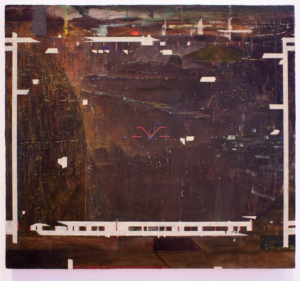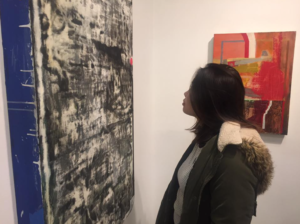Interviews with Artists
In 2017, as part of our ongoing commitment to arts dialogue and education, we began archiving interviews with the artists we have worked with at the Arts Research Collaborative. It is our hope that the collected conversations will continue to be a vital resource for all who visit.
From 2017-2018 UML student Matthew J. Jarbeau worked as an intern and preparator for the ARC. He interviewed Samnang Riebe in December 2017.
Why do you do what you do?
It wasn’t a preemptive thought. I never had this moment when I was a kid where I wanted to be an artist or a teacher or anything like that. To be honest, I just wanted to do something that was thrilling. I wanted to be a racecar driver, to be honest with you. And I never really had a calling in terms of something that I felt was rewarding in my life until painting, really. So once I kind of had that as a discipline in my life I couldn’t really let it go, or sort of dismiss it from my life. And that’s probably why I do what I do now. It’s such a part of me now, and I couldn’t really see myself without it.
What’s your background?
I didn’t really do any art in high school or middle school, besides from the sort of mandatory classes everyone was required to take at that age. But in terms of an artistic discipline, or a drawing discipline, I had absolutely none going into my undergraduate. And when I was in my undergraduate, I was doing graphic design more than I was doing fine arts. So, I had a lot of things I was interested in doing that were digitally based, and that had a lot to do with my interest now in painting but I don’t really think I have that much of a background. You could say my primary background is just playing with toys, maybe. And maybe you can say that my undergraduate experience is my background, but to go any further than that, you know, it feels raw.
How do you work?
I spend a lot of time thinking. I spend a lot of time thinking about seeing and looking. I had this funny sort of stubbornness about refusing to admit I had poor vision for the longest time. Maybe it was based on some sort of insecurity about wearing glasses, but I did not want to admit to myself that I had shitty eyes. But that was an interesting thought because it really helped me come to terms with abstraction as sort of an important tool within art. Just acknowledging that the way I saw might be unique even though it’s just blindness. So that has kind of always been present in the way I work, is just the thought of how do I bring that idea to everything I make. If I make something in my studio, what is the blind version of that? What is a less polished and more impure version of whatever I’m making? And so, I guess how I work comes from just pushing things around. I make drawings, of course. And I make paintings. It just starts out with pushing pigment around and imagining what something could be. Even if it’s just a color field. Because if I was really blind, color fields might really be, I don’t know, a soccer field. I guess that encapsulates how I work. Assembling things and then looking at it as if it could be something else.
What’s integral to your work?
Fiction would probably be the most integral part of my work. I don’t know if I can invest myself in making literal things. I don’t want to make something that looks like it has a utility and in fact does have that utility. Not to say that I don’t want to make paintings that look like paintings. But I do like the thought that there’s a little bit more loaded in the things that I make, like maybe a lore or an inflated history to the things I make. So, I guess the most integral thing to things I make require imagination and fiction.
What role does the artist have on society?
I think of artmaking as a very cultural practice. And without culture, society becomes a little bit catastrophic. I guess that’s where I find the role of the artist. They provide the culture, and it is a cultural practice the same way dance exists, or artisanry exists. It’s a mode of making, it’s a mode of thinking that’s enrichment. I think art is important. It’s hard to imagine how society would be without people who make things outside of capitalistic production. Not to say that artists can’t make things that can’t exist within commerce, but I think that our society places such a strong importance in two values. One being ethics, the other being science. The both follow within this binary of right and wrong and objective fact. While art is more interesting. There’s this author who wrote about the importance of acknowledging the idea of subjective truth. While I think our society puts a great deal of value on something like objective truth, subjective truth is something that a lot of us have dismissed. To say something subjective, such as sensory, does not mean it cannot be true. A subjective truth is along the lines of saying the ocean is salty. And while one can’t definitively say that the ocean is salty as an objective truth because you can only understand saltiness by actually tasting it, I think we can all agree that the ocean is salty.
What has been a seminal experience?
I think a seminal experience was the moment after I graduated when I was not making art for two years. To put it bluntly, it really sucked. Not to say that what I was doing wasn’t valuable. I was working for a nonprofit at the time, I was doing AmeriCorps for two years. And it was good, and I felt that what I was doing was impactful in my community. But I could tell that I wasn’t really the type of person that could contribute to society in a way that others could. By not making art for two years, I really felt something missing in my life. And I felt a lot of guilt about not making art. I felt like there was a lack of something. You could say that it was a seminal experience because in the crisis of not making, you realize there’s nothing more than that which you want to do. So if you take for granted being in school and having access to a studio and time, and at least for me I didn’t have to worry about money either. I’m a little bit blessed to have had a family to support me while I was in school so I could concentrate on making art. But once I was out, it was really hard to balance everything in the real world and still try to make art. So I guess that moment is what has driven me to make art again. And [artmaking] is something that is still wanted to do. And discipline and drive is what came about this; to really focus and try to make something that mattered to me. It mattered for me to make again. That was my seminal experience.
What artist has influenced you?
I don’t like having art heroes but I inevitably do. It’s also weird to have art heroes who are still alive because they are still making work. And in the grander scheme of things I would never really call them my contemporaries, but I guess they are. In terms of artists that I love but I’ve never met before, I would say maybe Gerhard Richter. It has a lot to do with how the gesture of negation exists within my own work. And letting that sort of gesture exist within my own work was a really big step for me to really open myself up to what could happen within art. For a while, the way I approached my art was to accumulate mark after mark, more and more. So the gesture of negation from Richter was something that was important for me. Probably because for the longest time I thought of painting as an additive process. And it seems so obvious now that painting isn’t just that, or artmaking in general isn’t just that. Richter has a way about being really confrontational about it. Richter did that for me.
If we were going to talk about your art, where would you want me to start?
I don’t think talking about any art should be a linear experience. I mean, painting isn’t a linear experience. And art isn’t a linear experience. So, you can start anywhere. We’d inevitably get everywhere, based on time. We could easily talk about the newest things I’ve made. We could easily talk about the first things I’ve made. And we’d circle around and accumulate some idea of what I am as an artist, I guess.
How has your practice changed over time?
I waste a lot less time. And it’s not because I’m in my studio more than I was. I think the biggest obstacle with my studio was anxiety. I think a lot of artists deal with the anxiety of making. I think every artist can relate to this thought, where they don’t want to make art that is bad or dumb etc. I think by letting go of that a little bit, it’s really helped me a lot. I make a lot of things in my studio that I don’t ever really turn into art. Sometimes I make something that just turns out to be a stool, just to sit on. I will take apart a coffee table and it’ll end up being nothing. I’ve disassembled power grill motors and turned it into a motorized arm device that moved back and forth but does absolutely nothing. I almost want to playfully call it a waste of time because they don’t actually do anything in my studio besides being these things. But I can’t help playing with these different ideas, I think it has something to do with maybe making something that I can call art. I don’t know what they’ll do now, but that practice can’t. And it really frees up what we would call creative practice.
What next?
I quit. [laughs] Well, I just had a show and that was nice. I just gotta keep making more. I had a really awesome teacher when I was here at UMass Lowell. His name was Jim Jeffers. It’s funny because he taught web design here, and that’s actually how I had him as a teacher as well, but he was one of my most important teachers to have for thinking like a fine artist. He didn’t really teach us web design in the classical sense. He wasn’t showing us specific things to do. He gave this good spiel about how artists are taught to teach themselves. And once you leave the confines of the comfy academic establishment of UMass Lowell, the things you learned inevitably will be outdated and it will be up to you to be a student and relearn it yourself. That approach to fine art is what I adopted, where I take the approach of always being the student within my own studio. So, I guess the next step is really just continuing with that moving forward.


